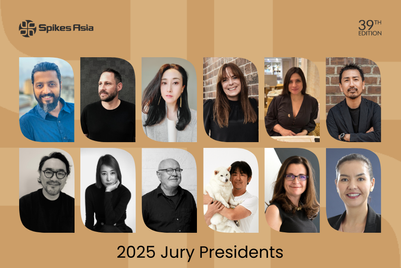
I have just spent the last few days judging the Design category at Spikes Asia. I was the only design judge from the Greater China region, so I took my duties very seriously.
Our jury president opened with the statement "design is bigger than advertising", which I agree with. Design can be a part of advertising, and also a part of many more aspects of brand communications which made it very interesting to judge.
We selected our Design Grand Prix with this in mind. It was 'Unforgotten Soldiers' from New Zealand. One thing it had above the other contenders was a sense of emotional engagement. There was some discussion as to how "original" the design was, as it was "recreating" something, not "creating" something.
However, we felt that overall it actually was “creating something original”—a black and white war in a modern day street. It mixed stage/set design, costume design and met the 'branded environment' category criteria perfectly.
Other work that stood out to me personally was 'Bookable Books', connecting Airbnb locations to places in literature via strategically placed bookmarks. Excellent thinking. I also liked the shortlisted entries for typography: 'A message to space', the 'Newspaper of sand' and 'Just'.
There was also discussion about work created more to solve a client problem versus work created to be entered into awards. This seemed especially noticeable in some poster design work that caused debate. While all the work we judged fulfilled the entry requirements, maybe they were not created in the spirit of helping a client, as much as the agency itself.
We tried to pick work that broke the category rules. Hibiki didn't use shots of grains and malts or successful men to sell whisky. Pola Apex didn't use regular images of beautiful women to sell skincare. Honda Engines didn't use manly blacks and silvers or sexy cars. The Thailand tourism board didn't use conventional tourist flyers but featured a tattoo.
It was very hard at times, with some of us really wanting work to get awarded and others feeling nothing towards it. One area that was disappointing to judge was the 'logos and branding' area. All the Design judges would love to see more quantity and quality there.
As an outsider to the network agencies running an independent company from Taiwan, it was nice to dip back into the industry and go away with new thoughts and inspiration.
Thank you Jacqueline, the local Spikes Taiwan rep for putting me forward to judge.
Ian Perkins is executive creative director of Name and Name in Taiwan



.jpg&h=334&w=500&q=100&v=20250320&c=1)


.jpg&h=334&w=500&q=100&v=20250320&c=1)
.png&h=334&w=500&q=100&v=20250320&c=1)
.jpg&h=334&w=500&q=100&v=20250320&c=1)









.jpg&h=268&w=401&q=100&v=20250320&c=1)
.jpg&h=268&w=401&q=100&v=20250320&c=1)